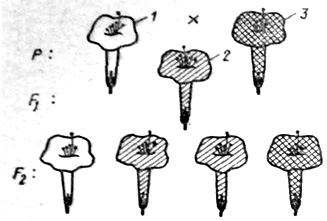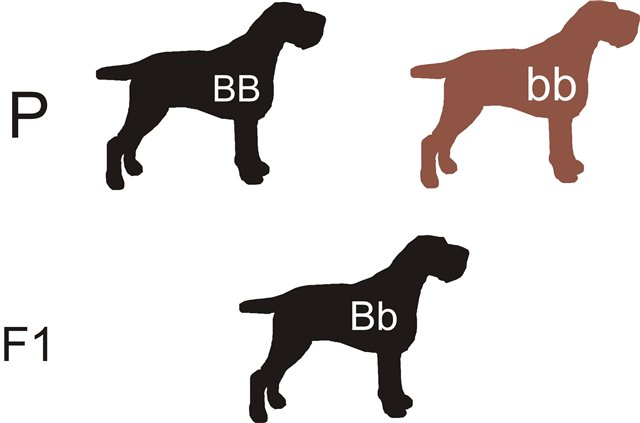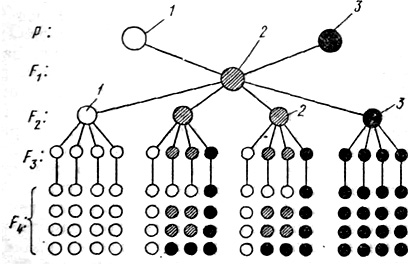
- •Institute of ecological safety
- •Methods of genetic analysis
- •1. The concept of genetic analysis.
- •2. Objects and objectives genetic analysis.
- •3. Methods for genetic research
- •3.1. Hybridological method
- •3.2. Genealogical method
- •3.3. Population-statistical method
- •3.4. Cytogenetic method
- •3.5. Biochemical method
- •3.6. Twins method
- •References
3. Methods for genetic research
In addressing the theoretical and practical genetic problems depending on the level of organization of living matter (molecular, cellular, organismal, population-species) scientists apply appropriate research methods.
3.1. Hybridological method
Hybridological method used H.Mendelem, is crossing (hybridization) organisms, which differ in certain conditions one or more inherited traits. Descendants obtained from such crosses are called hybrids (from the Greek. hybrid - a mix). Hybridization underlying hibrydological analysis - the study of the nature of inheritance states signs by means of crosses.
Crossbreeding is monohybrid, dyhybrid and polihybrid. Monohybrid crossing - a combination of parental forms, which differ in different states of a single genetic trait (eg seed color) dyhybrid - two traits (eg, seed color and structure of the surface), polihybrid - three or more.
The essence of the method hybridological study of heredity is that the genotype of an organism is judged on the grounds of his descendants received in certain crosses. The fundamentals of this method were laid works of Mendel. Mendel crossed each other varieties of peas, differing by certain characteristics (shape and color of seeds, flower color, stem height, etc.), and then watched as the inherited characteristics of both parents to their descendants in the first, second and subsequent generations of hybrids. Having done this work on a sufficiently large number of plants, Mendel was able to establish a very important statistical regularities of the proportion of hybrid plants that have characteristics of both the initial variety.
Later, similar studies have been carried out so many geneticists in various Mendel on peas, have biological significance, as confirmed in a wide variety of objects.
The simplest type of mating with hybridological analysis - monohybrid crossing when parental forms differ only by one pair of attributes. An example may serve as breeding monohybrid cross between yellow seed and green seed varieties of peas, Mendel spent. To explain the results, we use the notation adopted in genetics: P - parental forms (grades); F1-first generation hybrids - hybrids of the second generation (F3 - third, F4 - the fourth, and so on); X-crossing sign; ↓ - sign, indicating that the next generation is obtained by self-pollination, and A, and - two letters for a couple of contrasting traits that differ between parental forms, taken in cross (in this case, A - and a yellow - green color of peas).
Mendel obtained the following results for monohybrid crosses between yellow seed and green seed of peas:
P: A x a
F1: A
F2: 3А:1а
These results were summarized in the following three Mendelian principles: rule of uniformity of the first hybrid generation law of segregation second hybrid generation hypothesis purity of gametes.
1. Rule of uniformity of the first generation all first generation hybrids are similar to each other on the grounds obtained from the parents. In this particular case, all the F1 plants were with yellow seeds, ie, they have developed signs of only one parent. Such signs, which completely dominate the F1 called dominant. Opposing them symptoms do not appear in F1 and develop only in a certain part of individuals in the F2 and subsequent generations are called recessive. In the present case was a recessive green seed color.
Rule consistency confirmed for those cases where there is no sign of complete domination of one parent over the other signs. So, when crossed red flower ornamental plants "night beauty" with all the plants white flower F1 are pink (Fig.2), ie, on the grounds are intermediate between the original color of the flower shapes. In this case, the rule of uniformity of the first generation remains.

Fig.2: Example monohybrid crosses with incomplete dominance (crossing red and white beauties of night): 1 - white flowers. 2 – pink flowers, 3 - red flowers.

Fig.3: Example of rule of uniformity of the first generation all first generation hybrids are similar to each other on the grounds obtained from the parents.
2. Law of segregation or Mendel's first law, is, that when crossed with each other first-generation hybrids, or if they self-pollination in the second hybrid generation is split. Under the complete domination of (the case with peas) splitting in F2 is in the ratio of 3:1. This means that out of the total number of organisms F2 about 3/4 have a dominant trait, and 1/4 - recessive. Specifically in the law of Mendel put that out of 8023 F2 plants had yellow seeds 6022 and 2001 - the green. If incomplete dominance, the splitting in the F2 is expressed in the ratio of 1:2:1. Thus, in the case of the "night beauty" by crossing pink plants together in F2 plants with flowers appear three colours: fourth plant - with flowers red colour, 2/4-wire with flowers of pink and 1/4 - white colour with flowers .
Principled common 3:1 and 1:2:1 easy to install, following the inheritance of traits in Fz (Fig. 4). Results from crossing pea showed that not all plants have a dominant F2 yellow seed colour, give the same under self-progeny. Only a third of these plants green seed F2 (they are indicated in the figure open circles) in the next generation (F3) retains the yellow seed colour. It may be added that in the F4 and F5 from such plants under self will only receive green seed plants. In other words, in the progeny of plants green seed F2 will not be further split.

Fig.4: Monohybrid crossing scheme: 1 - homozygous individuals with a dominant trait, 2 - heterozygous ocobi with dominant or intermediate characters, 3 - individuals with the homozygous recessive.
